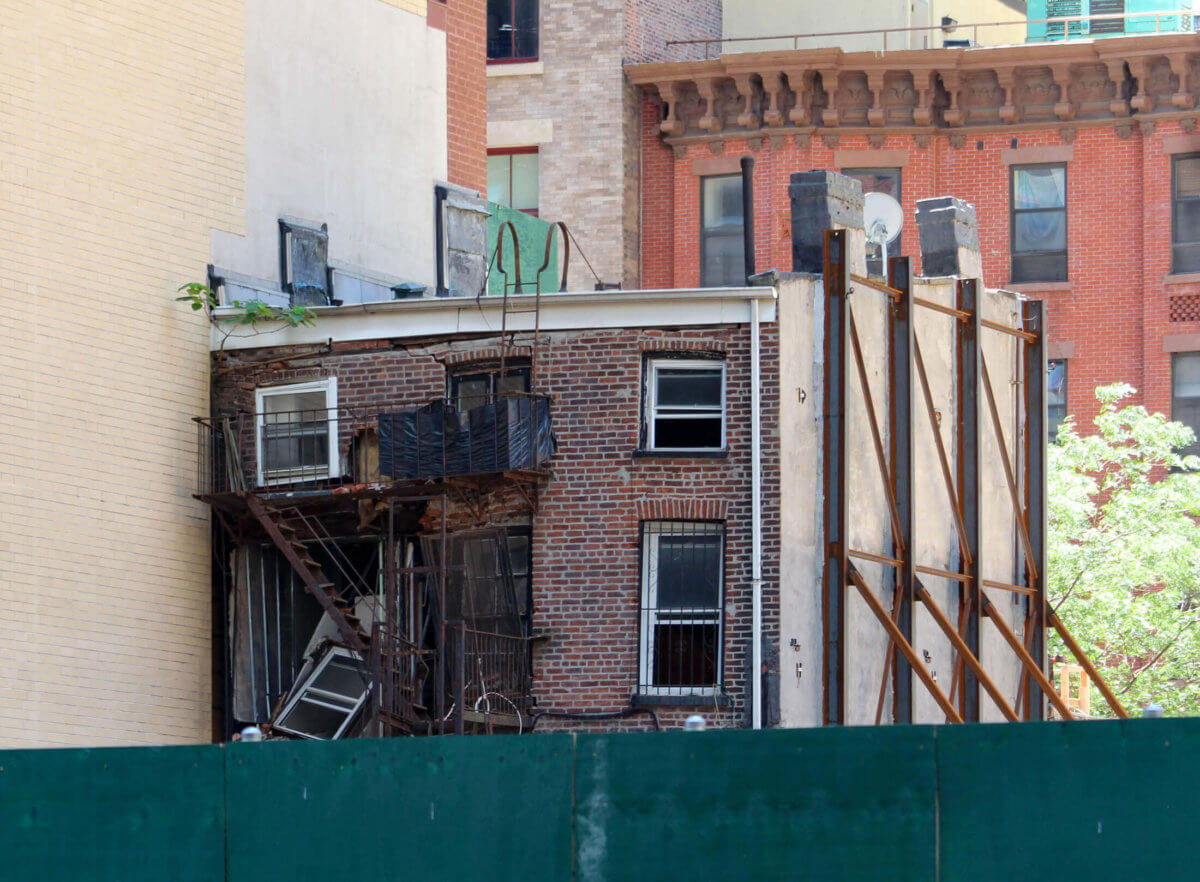Commercial Farming High Over Northern Boulevard in Long Island City
The 1919 factory building found at 37-18 Northern Boulevard, the Standard Motor Products Building, has long outlived its built purpose. Currently owned and operated by Acumen Capital Partners LLC, the gargantuan industrial building (301,000 Total SF in six stories) offers stoutly engineered and capacious floor space. Modern anchor tenants include the company which once owned the structure — Standard…

The 1919 factory building found at 37-18 Northern Boulevard, the Standard Motor Products Building, has long outlived its built purpose. Currently owned and operated by Acumen Capital Partners LLC, the gargantuan industrial building (301,000 Total SF in six stories) offers stoutly engineered and capacious floor space. Modern anchor tenants include the company which once owned the structure — Standard Motor Products –– as well as the Franklin Mint, the Jim Henson Company and Broadview Networks.
It’s an iconic structure, well known to those who use both the automotive path of Northern Boulevard or the locomotive path of the Long Island Railroad to commute to and from Manhattan. It’s a point of transition in the neighborhoods as well, the exit from Astoria and entrance to Sunnyside, where the designation of Steinway Street gives way to 39th Street.
The SMP building is across the street from the Hook and Ladder 66 building discussed in a Brownstoner Queens posting Long Island City’s Hook and Ladder 66 back in June, and looms over Northern Boulevard’s “Carridor” (a term which will be explored in the near future). In the shot below, after the jump, you are looking eastward, with Woodside and Jackson Heights on the horizon. The southern extant of Astoria is to the left and the triangular orange structure just off center is the end of Steinway Street at Northern Boulevard.
So, now you know where you are, but what you can’t see from the street is one of Queen’s hidden treasures, up on the roof.
When you step off the elevator, you begin to realize that you’ve entered the future.
Situated on the roof of the SMP Building is Brooklyn Grange, a 43,000 square foot commercial urban farm. The Brooklyn Grange also operates in the Brooklyn Navy Yard, but the Northern Boulevard operation is their flagship location. As a commercial urban farm, it both grows food and sells it.
The company produces roughly 50,000 pounds of fresh produce a year, and it maintains a robust CSA system which markets their crops to area restaurants, and directly to the community via farm stands and retail partners. Planning for the site started in 2009, planting began in the spring of 2010.
Luckily, the first person I encountered when exiting the elevator was actually the president of the company, Ben Flanner.
Ben is an industrial engineer who didn’t realize I was coming (I had set up my visit with Brooklyn Grange’s communications director Anastasia Cole Plakias). This unexpected meeting is mentioned, simply because here’s the president of the company harvesting lettuce for a customers order, and he’s not just getting dirty because he knew a camera was showing up.
The anecdote tells you a lot about the vibe and the people I met here — they didn’t just work up here, this place was their “work.” Ben welcomed me and then he went back to picking the day’s harvest, mentioning that he would see me later as was late for a meeting and that I should get photos of everything.
The crate was handed off to someone else, who was taking the vegetables to a prep area where they would be washed and packaged. Over the course of the morning, small groups of volunteers and employees began to show up to labor at the farm. Some were with City Growers, an educational non-profit which is maintained by the farm.
Brooklyn Grange undertook a lengthy search before they found this perfect spot in Long Island City, a place once called the “workshop of America.”.
Built as a factory, filled with metal stamping and electrical equipment, the SMP building was robustly constructed. It is adjacent to the titan Sunnyside Yards, which it once enjoyed direct access to. Mammoth industrial relics like this building distinguish the landscape of western Queens, and it is satisfying to see them find new purpose in the modern era. The structural integrity of the roof, and its load bearing capacity, were integral to the choice of the SMP building for this project.
Panoramic views are to be found in any direction desired. The post-industrial landscape, with its baroque mix of architectural styles, is laid bare. The smell at the farm is intoxicating as well, but the question everyone asks is “is it safe to eat, what about pollution?”
Anastasia Cole Plakias told me that recent environmental tests have shown that the air around the roof is significantly cleaner than that found at street level. Since the soil and fertilizers were brought in and artificially installed, they have nothing to worry about as far as ground pollution goes, but they test it as well. There are several layers of material underlying the soil bed, which control the drainage of water, and protect the roof itself from plant root infiltration. She also pointed out that that most of the large farming regions in the United States, like Salinas Valley in California, are awash in pollutants and that commercial farming has doused the land and water with decades of pesticides and weed killers.
The farm actually acts as a green roof, diverting large amounts of water away from the sewer system during rain events–a sort of green and brown sponge.
If you are not aware of the issue regarding storm water and the “Combined Sewer” system used by NYC, suffice to say that a quarter inch of rain- city wide- equates to a billion gallons of water entering the sewers. Older northeastern cities like NY have a combined sewer system, meaning that storm and sanitary sewers share pipes and weirs, and that when it rains heavily, sewage overflow mixes with storm water and the cocktail ends up discharged into area waterways. The NYC DEP does everything it can to keep this from happening, but there’s only so much that it can do, and that’s why you’ll see alerts admonishing against swimming at some beaches or rivers for a few days after a storm for fear of high bacterial counts in the water. A significant reason that so much water hits the sewers in the first place is because everything is made of waterproof concrete around here, and the agency is very interested in advancing so called “green infrastructure” projects around the city as a cheaper alternative to building more sewer plants or other “grey infrastructure” projects.
This CSO situation is a core issue at my beloved Newtown Creek, but it affects the entire harbor. Green sponges can help slow the flow, allowing the the city an opportunity to treat the torrent of storm water and sewage before it hits area waterways. According to Anastasia Cole Plakias, Brooklyn Grange manages about a million gallons a year of storm water at each of their locations.
Brooklyn Grange, through experience and trial, has emerged as an expert in the field of installing rooftop farms and green roofs. Jumping through bureaucratic, financial, and logistic hurdles, as well as dealing with the practical engineering and agricultural issues surrounding the exotic locale they’ve cultivated, has seasoned them. Nowadays, it’s what they do, and their skill is very much in demand. A new project in the Bronx is in the works, a partnership with SoBro, which will see them installing a very large green roof on a mixed-use building.
“We specialize in creating green space in unusual locations, literally anywhere something can grow,” says Anastasia Cole Plakias
The farm accepts composting materials, so bring them your vegetable cuttings and such. The farm is active for nine months of the year. For the other three, cover crops like rye, clover and oats are grown to nourish and protect the roughly 1.2 million pounds of soil from winter’s degradations. The stated goal of the company is to foster and install a culture of planting, specifically the planting of edible crops, in the urban environment.
They state that this will improve the air, and the water, and provide delicious food while doing so.
Brooklyn Grange is open to the public on Saturday’s from 11-3. Their produce is available for purchase, and they’ll be happy to show off this unique Long Island City business to you. The view from atop this structure is unique, and replete with New York City icons. Not to be missed, the farm is near the 36th Street station on the R and M lines, or the 39th Avenue stop on the N and Q. Check out their site for special events and Ben Flanner’s video tips on growing tomatoes.
They also have a chicken coop, and beehives.
Long Island City, where the last industrial revolution ended and the next one is just starting up.



















I Love It!
Hmmm, maybe I should move to Queens…